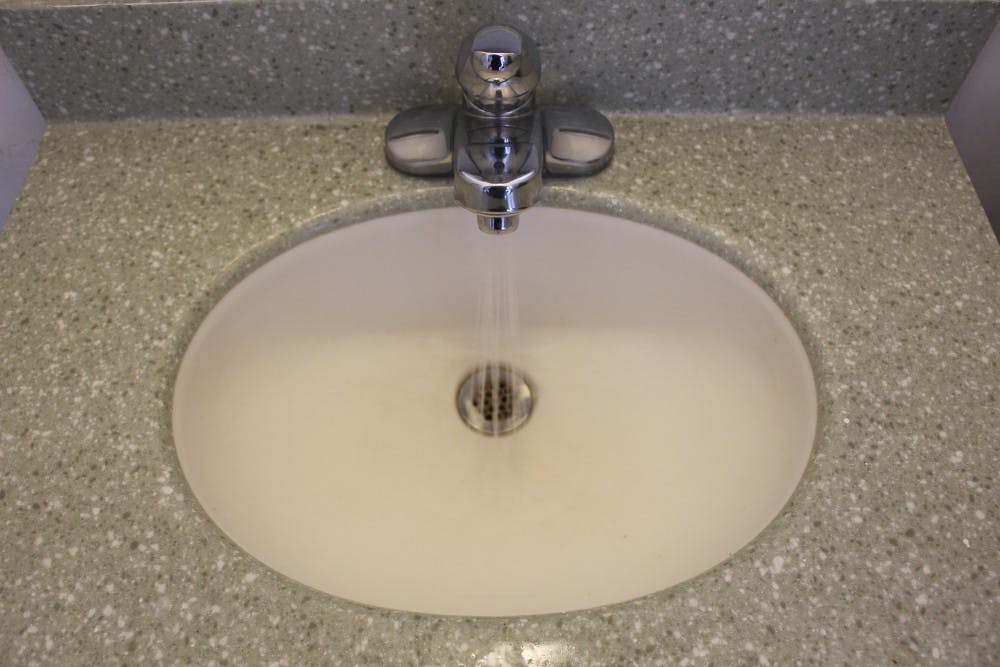
Philadelphia residents are gravely concerned on the quality of the city's water, in light of the incident in Flint, Michigan.
Credit: Brianna RaposoThe water crisis in Flint, Mich. has many in Philadelphia concerned about the safety of the city’s drinking water, but their problems are starkly different.
During a public hearing with the Philadelphia City Council described in a March 22 Philadelphia Magazine article, Debra McCarty, the Philadelphia Water Department commissioner stated, “Philadelphia’s drinking water is lead-free, and there are clear differences between Flint and Philadelphia.”
Flint’s water safety problem stems from the city’s emergency managers switching its water source to a local river whose water proved to be highly corrosive in 2014. In Philadelphia, potential water problems stem from buildings built before 1950 that can still have pipes with lead.
Richard Pepino, lecturer in the Department of History & Sociology of Science, said that a crisis like Flint could happen in Philadelphia because so much of the city’s problems are old, but now with all the attention on Flint, “I think all drinking water providers will take extra precaution.”
Lead service lines were banned nationwide in 1986, but some still remain in older homes whose owners cannot afford to pay for improvements. Water that flows through lead pipes can pick up large amounts of toxic metal.
It is estimated that there are 50,000 to 60,000 houses in Philadelphia that still have lead service lines. To prevent metal from filtering from pipes, the city adds an anticorrosive to the water supply.
Data collected by the Division of Disease Control in 2012 showed Philadelphia children with the highest lead levels concentrated in Center City, Roxborough-Manayunk and West Philadelphia.
Every three years the Philadelphia Water Department tests for lead in tap water for at least 50 representative taps of vulnerable homes in the city, according to the city government website. The Environmental Protection Agency’s Lead and Copper Rule requires these tests, which are used to determine if corrosion control treatment techniques are working, so that water has minimum potential for lead to leach from plumbing materials.
In the 2014 water tests, Philadelphia met federal and state standards. To meet standards, more than 90 percent of the sampled homes must have lead levels under the action level of 15 parts per billion. In 2014, 134 homes were tested, and 127 homes had lead levels below the action level of 15ppb. Ninety percent of tested homes had less than 5ppb.
Recently, the Centers for Disease Control and Prevention declared nationwide that, “no safe blood level in children has been identified.” But, according to the CDC, a blood lead level of 5 micrograms per deciliter is the threshold that should trigger public health action. Previously, the federal standard was 10 micrograms.
According to the Pennsylvania Department of Health, in 2014, 35,863 children under the age of 7 were tested for blood lead levels in Philadelphia. Of those children, 3,655, or 10.2 percent, had blood lead levels of five micrograms or greater. Comparing data to Flint, whose population is 15.5 times smaller than Philadelphia, the rate of lead exposure for five micrograms from 2014 to 2015 was 3.21 percent.
Even low levels of lead in blood have been shown to affect IQ, ability to pay attention and academic achievement. High levels of lead pose a serious threat to infants, young children and pregnant women. And effects of lead exposure cannot be treated.
Despite the national decrease in blood-lead levels, young children of urban minority families are found to be at the greatest risk of lead poisoning. Between 1999 and 2004, black children were 1.6 times more likely to test positive for lead in their blood than white children, according to the CDC.
Among all children, 11.2 percent of black children are poisoned compared with 2.3 percent of white children.
Pepino called this disparity an environmental injustice.
“Childhood lead poisoning selects its victims. And it selects its victims from communities that already have a number of environmental stressors,” he said.
The City Council Committees on Public Health and Human Services and Children and Youth held a public hearing on March 21 to identify best practices for the Philadelphia Water Department in order to continue and improve its prevention of lead exposure in the city’s outdated infrastructure.
Several announcements were made at the hearing, including a commitment by the Water and Public Health Departments to expand testing and oversight of lead exposure in child care centers. In addition, a plan to expand zero-interest loans for homeowners to replace lead service lines will be rolled out this year. The School District also committed to a full inventory of its water fountains.
The cost residents will have to pay to replace their lead pipes will be between $1,500-$2,000. Currently, there is no city or state funding to assist low-income residents with changing lead-service lines.
In a press release, 1998 College of General Studies graduate and former Daily Pennsylvanian staffer Helen Gym, chair of the Philadelphia Council’s Committee on Children and Youth, said in the wake of the water crisis in Flint and the discovery of increased lead levels in 30 Newark, N.J., school district buildings, it is important for Philadelphia to give additional scrutiny to the risks of lead exposure for the city’s youth.
“I am pleased to hear about the announcements made today, especially the District’s commitment to addressing access to safe, drinkable water in every single water fountain,” Gym said.
Pepino suggested additional policies including increased screening for elevated blood lead levels for all children in Philadelphia, lowering the classification of blood lead poisoning from 10 micrograms per deciliter of blood to five, giving additional funding to the lead court system and having health care providers pay for screenings for mothers.
The Daily Pennsylvanian is an independent, student-run newspaper. Please consider making a donation to support the coverage that shapes the University. Your generosity ensures a future of strong journalism at Penn.
DonatePlease note All comments are eligible for publication in The Daily Pennsylvanian.




